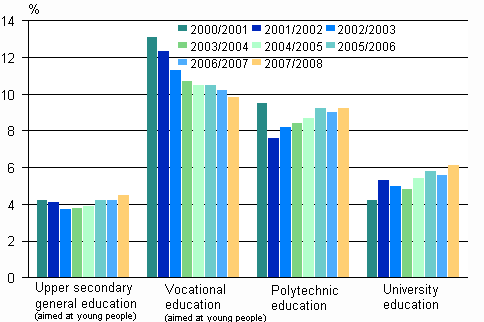Published: 12 March 2010
Discontinuation of education increased elsewhere except for vocational education
Six per cent of students attending education leading to a qualification or degree discontinued their studies and did not resume them in any education leading to a qualification or degree during the 2007/2008 academic year. In upper secondary general education aimed at young people the discontinuation percentage was 4.5, in vocational education aimed at young people it was ten, in polytechnic education nine, and in university education six per cent. Taking into consideration the students who have changed their sector of education, e.g. the students who have switched from upper secondary general school to vocational education, lowers the percentages of discontinuation. Compared with the previous academic year, discontinuation increased slightly in all sectors of education except for vocational education where it decreased. These data derive from Statistics Finland’s Education Statistics.
Discontinuation of education in upper secondary general, vocational, polytechnic and university education in academic years from 2000/2001 to 2007/2008

Male students discontinued studies more frequently than female students. The difference between the genders in discontinuation of education was largest in polytechnic education where the rate of discontinuation was over 11 per cent among male students and 7.5 per cent among female students. Education was discontinued the most in the field of natural sciences and the least in the field of other education (e.g. police work) as well as in the fields of social welfare, health and physical exercise.
A total of 189 students had discontinued studies in comprehensive school during the 2008/2009 academic year. The number of those who had dropped out completely from compulsory education was 39 and of those over the age of compulsory education having left comprehensive school without a leaving certificate was 150. The number of school drop-outs rose by 27 from the previous academic year.
Discontinuation of education leading to a qualification or degree by sex and sector of education in academic year 2007/2008 1)
| Sex / sector of education | Number of students used in the statistics on discontinuation of education 20. Sept. 2007 | Discontinued in own sector of education | Changed sector of education | Discontinued completely education leading to a qualification or degree | |
| % | % | % | |||
| Total | 506 899 | 7,5 | 1,6 | 5,9 | |
| Upper secondary general education (aimed at young people) | 103 903 | 4,5 | 2,3 | 2,2 | |
| Vocational education (aimed at young people) | 122 995 | 9,8 | 0,9 | 8,9 | |
| Polytechnic education (Bachelor's degrees) | 128 866 | 9,2 | 2,3 | 6,9 | |
| University education (Bachelor's and Master's degrees) | 151 135 | 6,1 | 0,9 | 5,2 | |
| Men | Total | 238 615 | 8,5 | 1,5 | 7,0 |
| Upper secondary general education (aimed at young people) | 44 676 | 4,8 | 2,4 | 2,4 | |
| Vocational education (aimed at young people) | 65 593 | 9,8 | 0,7 | 9,1 | |
| Polytechnic education (Bachelor's degrees) | 58 794 | 11,3 | 2,4 | 8,8 | |
| University education (Bachelor's and Master's degrees) | 69 552 | 7,3 | 1,0 | 6,3 | |
| Women | Total | 268 284 | 6,5 | 1,6 | 4,9 |
| Upper secondary general education (aimed at young people) | 59 227 | 4,3 | 2,3 | 1,9 | |
| Vocational education (aimed at young people) | 57 402 | 9,9 | 1,2 | 8,7 | |
| Polytechnic education (Bachelor's degrees) | 70 072 | 7,5 | 2,2 | 5,3 | |
| University education (Bachelor's and Master's degrees) | 81 583 | 5,0 | 0,8 | 4,2 | |
Source: Education 2008. Statistics Finland
Inquiries: Riikka Rautanen (09) 1734 2375, koulutustilastot@stat.fi
Director in charge: Jari Tarkoma
Publication in pdf-format (195.9 kB)
- Tables
-
Tables in databases
Pick the data you need into tables, view the data as graphs, or download the data for your use.
Appendix tables
Updated 12.3.2010
Official Statistics of Finland (OSF):
Discontinuation of education [e-publication].
ISSN=1798-9302. 2008. Helsinki: Statistics Finland [referred: 19.4.2025].
Access method: http://stat.fi/til/kkesk/2008/kkesk_2008_2010-03-12_tie_001_en.html

